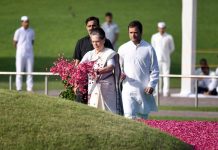 Prime Minister Narendra Modi’s iteration on 19 June at the All-Party Meeting (APM) on the ongoing India-China crisis that ’neither have anyone intruded into our border, nor has any post been taken over by anyone’ in the Galwan at the All-Party Meeting (APM) on the ongoing India-China crisis in the Union Territory of Ladakh has given rise to many questions, especially in the wake of satellite images pouring in depicting presence of Chinese troops and vehicles in large numbers in the vicinity of site where 20 jawans of Indian Army were martyred on 15 June. Some experts along with opposition parties feel that by denying any intrusion by China into Indian territory, PM Modi has seemingly ‘acquiesced’ to Chinese claim in eastern Ladakh. Some experts have also opined that PM Modi’s denial statement not only provides legitimacy to China’s formal claim over the Galwan Valley, albeit also put at stake his ‘muscular strongman’ image built so diligently and publicized over the past half-decade, entailing the potential of endangering his political fortunes in near future.
Prime Minister Narendra Modi’s iteration on 19 June at the All-Party Meeting (APM) on the ongoing India-China crisis that ’neither have anyone intruded into our border, nor has any post been taken over by anyone’ in the Galwan at the All-Party Meeting (APM) on the ongoing India-China crisis in the Union Territory of Ladakh has given rise to many questions, especially in the wake of satellite images pouring in depicting presence of Chinese troops and vehicles in large numbers in the vicinity of site where 20 jawans of Indian Army were martyred on 15 June. Some experts along with opposition parties feel that by denying any intrusion by China into Indian territory, PM Modi has seemingly ‘acquiesced’ to Chinese claim in eastern Ladakh. Some experts have also opined that PM Modi’s denial statement not only provides legitimacy to China’s formal claim over the Galwan Valley, albeit also put at stake his ‘muscular strongman’ image built so diligently and publicized over the past half-decade, entailing the potential of endangering his political fortunes in near future.
Undefined LAC
Of the 15, 106.7 km long land border India shares with its neighbours, India’s land border with People’s Republic of China (PRC) is 3, 488 km and a part of this border is not properly demarcated, especially in Ladakh region and this is often known as Line of Actual Control (LAC), a term coined by the then PRC premier Zhou Enlai in late 1950s and has been in vogue since then. In the aftermath of the 1962, after having occupied a major chunk of Ladakh region, known as Aksai Chin, the Chinese version of the LAC was the line of actual control that existed after the Chinese attack in September 1962, whereas India insisted that LAC should be based on the actual position on 8 September 1962 prior to the Chinese attack. Thus,vagueness continued to rule the roost in the context of LAC and Beijing continued its tactical game of changing facts on the ground militarily. In the wake of signing of the 1993 Agreement to Maintain Peace and Tranquility at the LAC between India and China, the LAC was accepted by both sides as it existed at the time of signing of the Agreement. The LAC is only a concept neither agreed to by the two countries nor delineated on a map or demarcated on the ground and there is no publicly available map depicting Indian version of the LAC. During his visit to China in May 2015, PM Modi’s proposal to clarify the LAC was rejected by Beijing.
Thus far, twenty-two rounds of boundary talks have taken place between the two countries, without any worthwhile outcome. India continues to claim the entire Aksai Chin and China claims areas along a line, best described by India as the line of “Chinese perception”. Currently, the boundary in eastern Ladakh is over 800 kms with LAC being nearly 550 kms. Undoubtedly, both India and China have been continuing making roads and tracks on their respective sides, nonetheless, China having the advantage of terrain which is more open, plain and served by Western highway, has built disproportionate strategic and military assets in the Galwan Valley. And amidst the ongoing crisis in the Galwan Valley, China has laid its claim over the entire Valley.
Encirclement of India
China has made deep inroads into India’s immediate neighbours in the Himalayan region, especially in Nepal and Bangladesh by providing massive economic aid and building strategic infrastructure. Pakistan is already in the tight Chinese grip through China-Pakistan Economic Corridor (CPEC) entailingChinese investment worth $62 billion with specific emphasis on building strategic infrastructure in Pakistan-occupied Kashmir (PoK) in proximity to Indian borders. China has provided worth $2.5 billion military aid to Nepal recently along with NepaleseRs 56 billion assistance to Kathmandu, apart from developing strategic infrastructure in Nepal, including border roads. Emboldened by its close ties with Beijing, Nepal’s parliament has recently passed a new map of the country that includes Indian territory of Kalapani, Lipulekh and Limpiyadhura despite protests from India. Modi government’s blowing the issue of illegal Bangladesh immigrants out of proportion to gain domestic political mileage has not only angered Bangladesh and pushed Dhaka towards China. Bangladesh is the second largest receiver of Chinese investment after Pakistan in South Asia and under China’s Belt and Road Initiative (BRI) related investment in Bangladesh stands around $38 billion. China has provided massive economic assistance to Sri Lanka and under the BRI Sri Lanka got huge amounts the debt of which is piling up thereafter forcing Colombo to lease Hambantota to China for 99 years.
In other words, by bringing India’s immediate neighbours into its sphere of influence, China has meticulously built up its strategy of encircling India via land in South Asia and these neighbours can be easily harnessed by Beijing in arousing anti-India sentiments. There is no denying the fact that Modi government’s cynical use of foreign policy towards immediate neighbours has resulted in India losing the South Asia influence to Chinese hegemonism.
China’s Economic Clout
The ongoing India-China border face-off at Galwan Valley in Ladakh has raised the hackles of Indians with growing demands for immediately banning trade with China and boycotting products produced by it. Given the fact of heavy penetration of Chinese products into the India market — ranging from heavy machinery to pharmaceuticals to electronics — immediate ban on Chinese goods does not seem to be a viable option to teach China a lesson. India is not a major player in China’s trade scenario because China accounts for 5% of India’s exports and 14% of India’s imports. China exports only 3 per cent of its total to India. At the same time, what India exports to China make up to less than 1% of its imports. And in this backdrop, trade experts opine that India cannot hurt China economically by restraining from trading with Beijing. Espousing for a well-calibrated incremental approach to reduce dependence on Chinese imports, experts advise that India ought to buy goods from China at the lowest possible price and make efforts to manufacture those products domestically to gradually reduce dependence on China.
Being a major player in the global trade and holding a prime position in the global trade and the value chains, compared to India, which is insignificant, China enjoys massive economic clout. Experts opine that a blanket ban on Chinese goods is simply not feasible because even if people buy a computer from a different country other than China, the microchips in it might be manufactured in China. Hence, just saying Chinese products should be boycotted is an impractical proposition at this critical juncture when Indian economy is already in doldrums.
Way Forward
The tragic incident at Galwan that claimed martyrdom of our 20 jawans, is a flashpoint of the worst kind in recent times. The ongoing fragile situation gives rise to various questions such as: Can both countries, having large conventional forces backed by nuclear weapons, go to war that too when the world is reeling from the COVID-19 pandemic? Why China chose to display such belligerence at this time? What are China’s designs vis-à-vis India? Answers to these questions lie in Beijing’s behaviour and as to how India responds to it. Modi government’s investment of six years towards building a working relationship during five visits and 18 meetings with President Xi Jinping spiraled southward. Some experts feel that Modi government’s China policy has been its biggest foreign policy disappointment. One strategic expert has gone to the extent of saying that even if India emerges from the stalemate completely ‘unscathed’, the credit for the same would go to our defence forces’ capacities and not to diplomacy, that failed to read between the lines of Chinese intent.
A long time defence and strategic policy is the need of the hour and any mismatch between domestic and external polices should be avoided. Policy towards immediate neighbours should be revitalized. While modernizing our defence preparedness, we need to build up our economic clout to match China.











